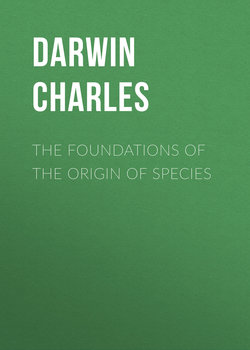Читать книгу The Foundations of the Origin of Species - Чарльз Дарвин, Darwin Charles - Страница 9
PART II 104
§ IX. «Abortive organs.»
ОглавлениеThere is another grand class of facts relating to what are called abortive organs. These consist of organs which the same reasoning power that shows us how beautifully these organs in some cases are adapted to certain end, declares in other cases are absolutely useless. Thus teeth in Rhinoceros165, whale, narwhal, – bone on tibia, muscles which do not move, – little bone of wing of Apteryx, – bone representing extremities in some snake, – little wings within «?» soldered cover of beetles, – men and bulls, mammæ: filaments without anthers in plants, mere scales representing petals in others, in feather-hyacinth whole flower. Almost infinitely numerous. No one can reflect on these without astonishment, can anything be clearer than that wings are to fly and teeth «to bite», and yet we find these organs perfect in every detail in situations where they cannot possibly be of their normal use166.
The term abortive organ has been thus applied to above structure (as invariable as all other parts167) from their absolute similarity to monstrous cases, where from accident, certain organs are not developed; as infant without arms or fingers with mere stump representing them: teeth represented by mere points of ossification: headless children with mere button, – viscera represented by small amorphous masses, &c., – the tail by mere stump, – a solid horn by minute hanging one168. There is a tendency in all these cases, when life is preserved, for such structures to become hereditary. We see it in tailless dogs and cats. In plants we see this strikingly, – in Thyme, in Linum flavum, – stamen in Geranium pyrenaicum169. Nectaries abort into petals in Columbine «Aquilegia», produced from some accident and then become hereditary, in some cases only when propagated by buds, in other cases by seed. These cases have been produced suddenly by accident in early growth, but it is part of law of growth that when any organ is not used it tends to diminish (duck’s wing170?) muscles of dog’s ears, «and of» rabbits, muscles wither, arteries grow up. When eye born defective, optic nerve (Tuco Tuco) is atrophied. As every part whether useful or not (diseases, double flowers) tends to be transmitted to offspring, the origin of abortive organs whether produced at the birth or slowly acquired is easily understood in domestic races of organisms: [a struggle between the atrophy and hereditariness. Abortive organs in domestic races.] There will always be a struggle between atrophy of an organ rendered useless, and hereditariness171. Because we can understand the origin of abortive organs in certain cases, it would be wrong to conclude absolutely that all must have had same origin, but the strongest analogy is in favour of it. And we can by our theory, for during infinite changes some organ, we might have anticipated, would have become useless. «We can» readily explain the fact, so astounding on any other view, namely that organs possibly useless have been formed often with the same exquisite care as when of vital importance.
Our theory, I may remark would permit an organ «to» become abortive with respect to its primary use, to be turned to any other purpose, (as the buds in a cauliflower) thus we can see no difficulty in bones of male marsupials being used as fulcrum of muscles, or style of marygold172, – indeed in one point of view, the heads of [vertebrated] animal may be said to be abortive vertebræ turned into other use: legs of some crustacea abortive jaws, &c., &c. De Candolle's analogy of table covered with dishes173.
«The following passage was possibly intended to be inserted here.» Degradation and complication see Lamarck: no tendency to perfection: if room, [even] high organism would have greater power in beating lower one, thought «?» to be selected for a degraded end.
165
Some of these examples occur in Origin, Ed. i. pp. 450-51, vi. pp. 619-20.
166
The two following sentences are written, one down the margin, the other across the page. “Abortive organs eminently useful in classification. Embryonic state of organs. Rudiments of organs.”
167
I imagine the meaning to be that abortive organs are specific characters in contrast to monstrosities.
168
Minute hanging horns are mentioned in the Origin, Ed. i. p. 454, vi. p. 625, as occurring in hornless breeds of cattle.
169
Linum flavum is dimorphic: thyme gynodiæcious. It is not clear what point is referred to under Geranium pyrenaicum.
170
The author’s work on duck’s wings &c. is in Var. under Dom., Ed. 2, i. p. 299.
171
The words vis medicatrix are inserted after “useless,” apparently as a memorandum.
172
In the male florets of certain Compositæ the style functions merely as a piston for forcing out the pollen.
173
«On the back of the page is the following.» If abortive organs are a trace preserved by hereditary tendency, of organ in ancestor of use, we can at once see why important in natural classification, also why more plain in young animal because, as in last section, the selection has altered the old animal most. I repeat, these wondrous facts, of parts created for no use in past and present time, all can by my theory receive simple explanation; or they receive none and we must be content with some such empty metaphor, as that of De Candolle, who compares creation to a well covered table, and says abortive organs may be compared to the dishes (some should be empty) placed symmetrically!
